Fetch.ai is building a decentralized AI-driven economy where autonomous Economic Agents (AEA) can interact across industries, optimize processes, and automate services. Its open-source platform seamlessly integrates AI into existing systems, enabling businesses to enhance efficiency and reduce reliance on intermediaries.
With applications across various industries such as DeFi, smart cities, and supply chains, Fetch.ai is expanding into the trillion-dollar AI market through blockchain-driven automation.
Key Insights
- Scaling Decentralized AI Vision – With the accelerated adoption of decentralized AI, Fetch.ai is at the forefront, providing scalable, agent-based autonomous interactions across industries.
- Infrastructure and Innovation - The $100M Fetch Compute Program ensures high-performance GPUs, while the Fetch.ai Innovation Lab and $10M global Innovation Fund support early-stage AI startups, strengthening the ecosystem and accelerating the adoption of decentralized AI.
- Strategic Partnerships: ASI Alliance – Fetch.ai plays a core role in the ASI Alliance, unifying $FET, $AGIX, and $OCEAN under a single ecosystem for the $ASI token to integrate AI innovations, with CUDOS also integrated into the alliance.
- AI-Driven Advancements – The launch of ASI-1 Mini is the first native LLM product designed specifically for agent AI in Web3, enabling efficient on-chain AI execution, allowing users to train, invest in, and own AI models—potentially reshaping AI ownership in Web3.
Fetch.ai: Ecosystem Overview
Fetch.ai is a blockchain-based decentralized AI platform designed to support autonomous machine learning and AI-driven economic agents. It provides an infrastructure where independent AI agents can interact, execute transactions, and integrate with dApps across multiple industries.
Founded in Cambridge in 2017, Fetch.ai launched its mainnet in January 2020, combining blockchain and artificial intelligence for secure and transparent data sharing.
Key Features:
- Autonomous Economic Agents – AI-driven agents that handle transactions, negotiations, and data exchanges.
- Decentralized Machine Learning – Secure, collaborative AI training without intermediaries.
- Open Infrastructure – Integrate AI into existing systems without modifying APIs.
The applications of Fetch.ai range from optimizing financial trading strategies and advancing smart city infrastructure to improving public transport routes, enabling gig economy interactions, and managing decentralized energy networks.
Fetch.ai aims to lay the foundation for a scalable, secure, and decentralized AI economy, linking blockchain technology with real-world industry applications.
Core Components
The core components of Fetch.ai — Agents, Agentverse, AI Engine, and Fetch Network — work together to enable autonomous AI-driven automation in a decentralized digital economy.
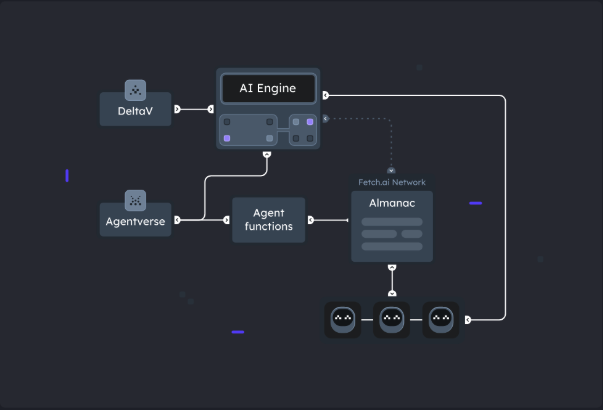
Source: Fetch.ai Official Documentation
- Agents: Building blocks of the Fetch.ai ecosystem
Agents are autonomous, decentralized programs that can independently search, trade, and collaborate to perform tasks across various domains without human intervention.
They handle problem-solving, market trading, computational tasks, data validation, and communication, as well as applications across different fields.
Fetch.ai agents operate on the uAgents framework, an open-source library that simplifies development and ensures efficient execution within the ecosystem.
- Agentverse: Agent Deployment Platform
Agentverse is a SaaS platform for deploying, registering, and managing autonomous agents, providing a central hub for developers to build and scale AI-driven solutions.
It supports global agents, pre-built templates for rapid development, and seamless integration with real-world applications, ensuring continuous uptime and efficient execution.
Agents hosted on Agentverse benefit from real-time modifications and streamlined automation, making them a critical infrastructure component within the Fetch.ai ecosystem.
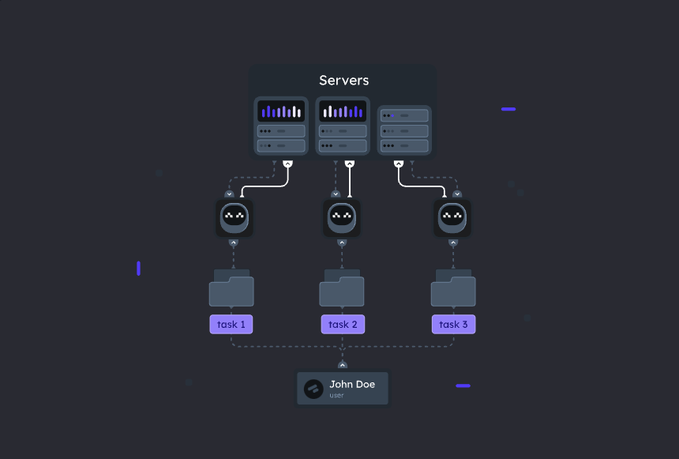
- AI Engine: Intelligent Layer
The AI Engine is the core of Fetch.ai automation, connecting users and agents by transforming human input into structured tasks.
It processes natural language, converting requests into executable tasks, and connects with DeltaV for seamless interaction while using Smart Routing to optimize agent selection.
It is powered by large language models (LLMs) that enhance decision-making, automate problem-solving, and ensure efficient task execution across the ecosystem.
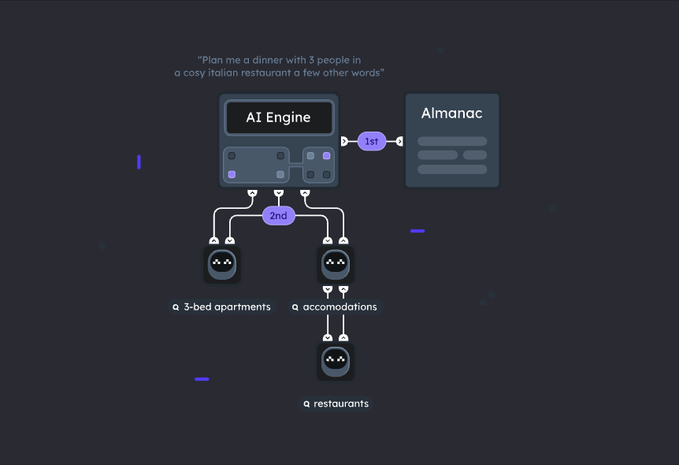
Source: Fetch.ai Official Documentation
- Fetch Network: Decentralized Foundation
Fetch.ai operates the [CometBFT] consensus mechanism (formerly known as Tendermint) as an independent Cosmos SDK blockchain, enabling IBC interoperability with other Cosmos-based networks.
Fetch Network is the blockchain pillar of Fetch.ai, ensuring secure, transparent, and decentralized coordination among agents.
It includes the Almanac contract for agent registration, the Fetch Name Service (FNS) for easier discoverability, and the Fetch Ledger for immutable record keeping.
It is powered by $FET (approved for transition to $ASI), facilitating transactions, incentivizing participation, and enabling seamless agent interactions, aligning Fetch.ai with the broader AI superintelligent economy for scalable AI coordination and decentralized automation.
Fetch.ai has expanded into the Ethereum and Binance Smart Chain (BSC) ecosystems, launching ERC-20 and BEP-20 versions of $FET to enhance liquidity and access to DeFi applications.
Achievements and Technological Advancements of Fetch.ai
Growth, Innovation, and Developer Adoption
Fetch.ai achieved significant growth in 2024, recording over 24M transactions, 130K+ active wallets, and over 400M $FET staked. The launch of innovation labs in San Francisco, London, and India, along with global hackathons and academic collaborations, strengthened its commitment to decentralized AI development.
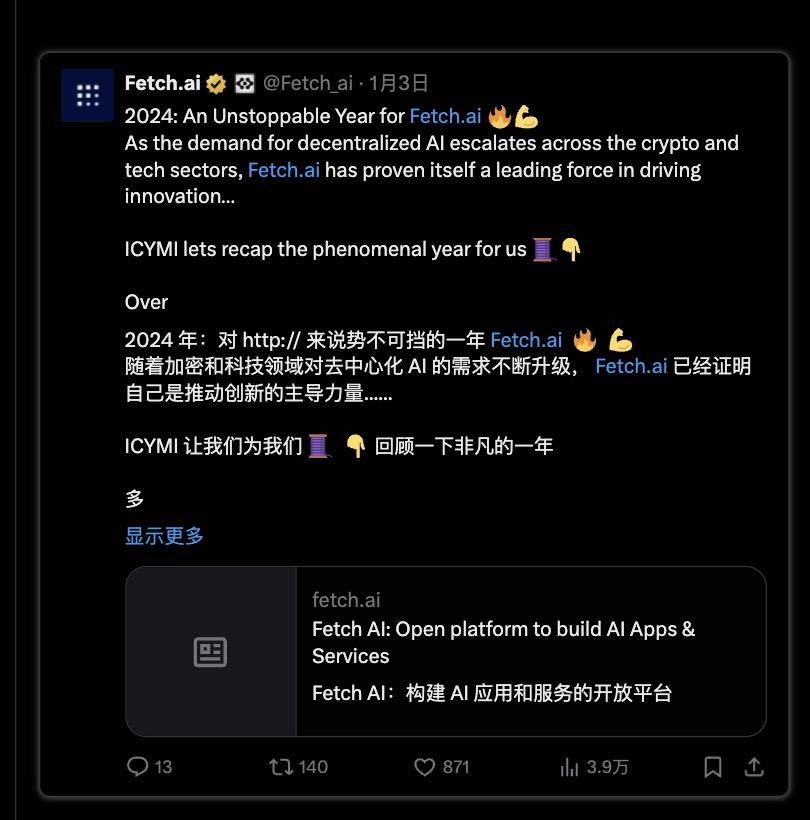
Advancing AI Infrastructure
A $10M global Innovation Fund was introduced to support early-stage AI startups, while the $100M Fetch Compute Program secured high-performance GPUs to drive scalable AI applications. These efforts, along with new research centers, reinforced Fetch.ai’s position in the decentralized AI ecosystem.
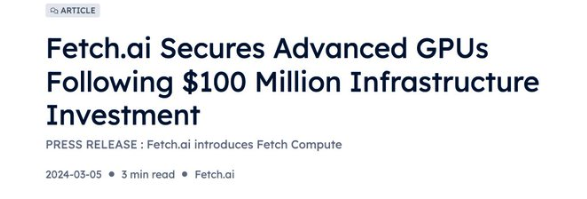
Source: Fetch.ai Official Blog
ASI-1 Mini: A Leap in AI Efficiency
Fetch.ai launched ASI-1 Mini, a Web3 native LLM product designed to enhance efficiency, capable of running on just 2 GPUs while delivering high performance. With multi-step reasoning and autonomous workflows, it can improve decision-making and enable users to invest in, train, and own AI models.

- The Game Company (TGC) is integrating ASI-1 Mini into its AI-driven cloud gaming platform to advance real-time interactions and immersive gaming experiences.
- Functionland is integrating ASI-1 Mini with its NPU-driven hardware to achieve decentralized AI with full privacy and user ownership.
- AI integrated ASI-1 Mini, allowing developers and researchers to benchmark, validate, and deploy models in a transparent and decentralized environment.
- GamiFi has also integrated ASI-1 Mini, bringing AI-driven warriors to its PvP gaming platform, enabling players to command AI agents in-game.
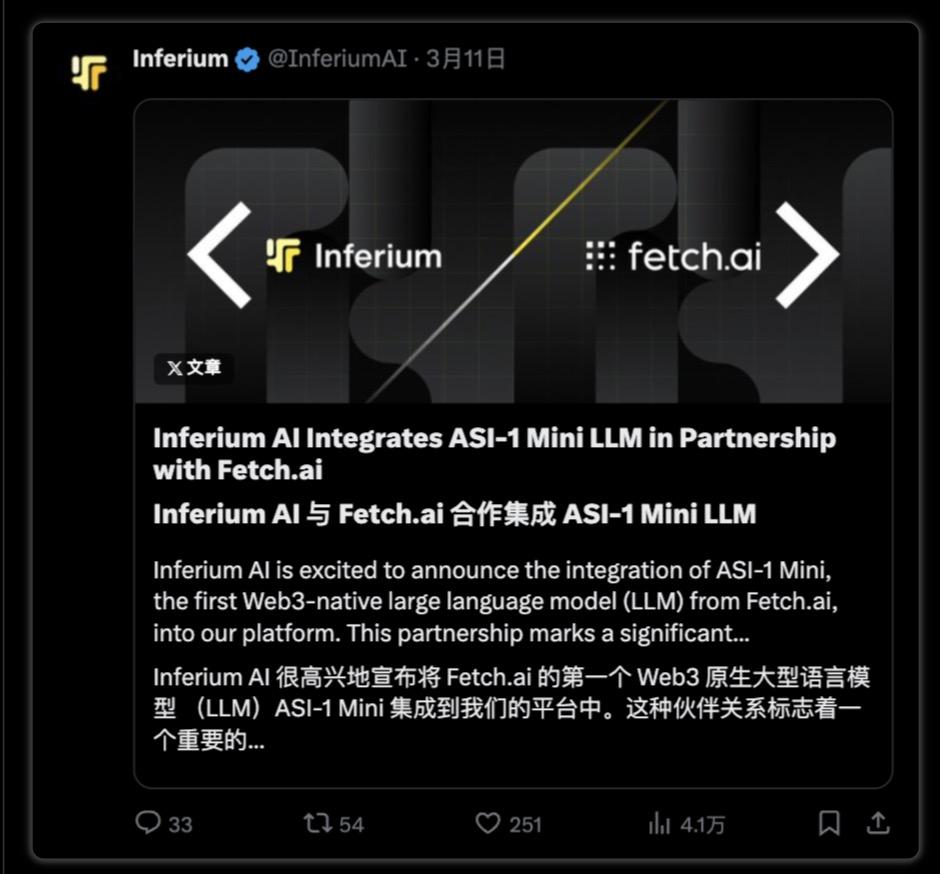
Ecosystem Growth
Fetch.ai is a key participant in the ASI Alliance, merging $FET, $AGIX, and $OCEAN into a unified AI-driven ecosystem. Strategic partnerships with Ankr, CUDOS, and other companies expand its AI and blockchain capabilities, while the launch of the ASI mobile wallet and integration with Chainlink reflects the ongoing expansion of the ecosystem.
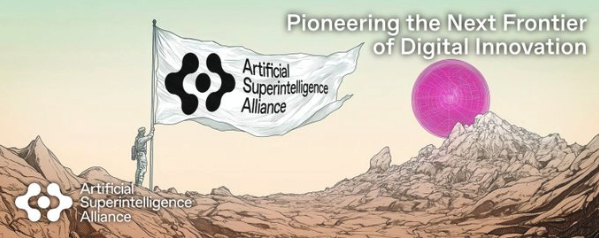
ASI Alliance: A Decentralized AI Powerhouse
The Artificial Superintelligence Alliance (ASI), composed of Fetch.ai, SingularityNET, and Ocean Protocol, was announced in March 2024 with the goal of developing a decentralized AI ecosystem. By integrating autonomous AI agents, decentralized marketplaces, and blockchain-based data sharing, the alliance aims to provide a viable alternative to centralized AI models.
ASI challenges the centralized control of AI by promoting ethical governance and open infrastructure. By eliminating corporate gatekeepers, it ensures transparency, accessibility, and alignment with human values. Open-source collaboration prevents monopolies and allows for global contributions. With the combined strengths of its founding projects, ASI drives the development of decentralized, secure, and inclusive AI.
A significant step in the initiative is the merging of their native tokens ($FET, $AGIX, and $OCEAN) into a single token $ASI, aimed at simplifying their ecosystem and enhancing interoperability. The merger was originally scheduled for June 13, 2024, but has been rescheduled to July 15, 2024.
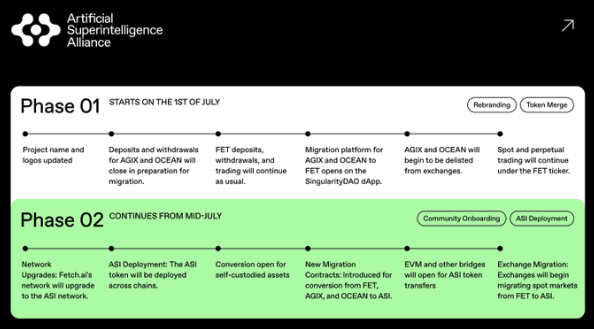
Source: ASI Official Website
Founding Projects
The ASI Alliance builds on the strengths of its three founding blockchain AI projects, each contributing unique capabilities to the decentralized AI space.
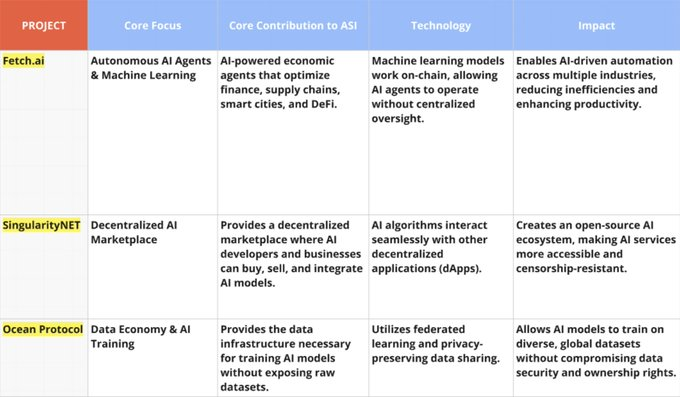
Source: Internal Analysis
CUDOS later joined the ASI Alliance, adding decentralized cloud computing to the ecosystem. Through this integration, the alliance aims to reduce costs, improve efficiency, and enhance the scalability of AI applications.
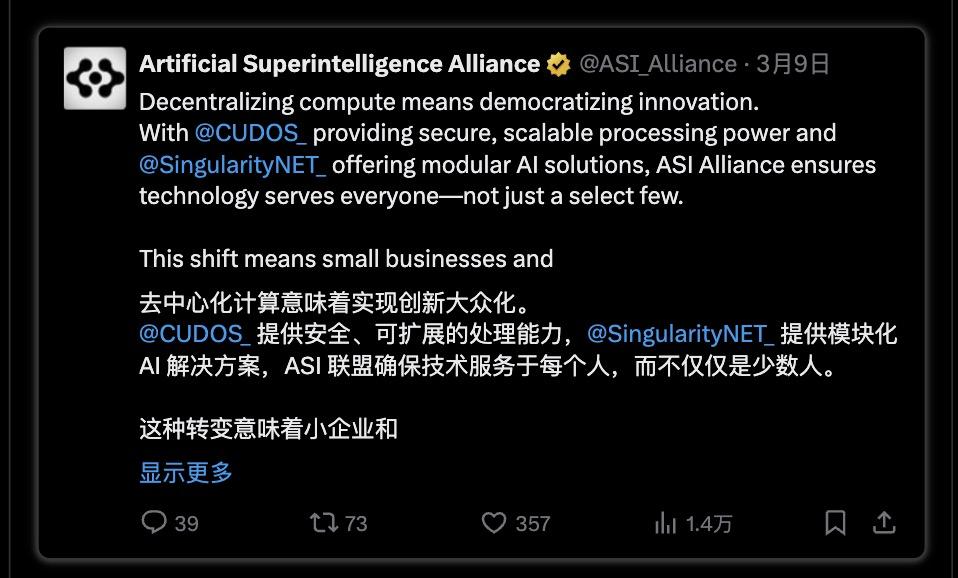
Team Members
The Artificial Superintelligence Alliance team consists of key members from Fetch.ai, SingularityNET, Ocean Protocol, and CUDOS, who have deep backgrounds in artificial intelligence, blockchain, and decentralized computing.
The alliance is led by experts such as Ben Goertzel and Humayun Sheikh, focusing on building an open and secure AI for the future.

Source: ASI Official Website
Challenges and Future Outlook
Challenges
Fetch.ai and the ASI Alliance face several obstacles in their pursuit of decentralized AI:
- Competition from centralized AI giants, which dominate the market with abundant resources, advanced infrastructure, and widespread adoption.
- Increasing competition from other Web3 AI projects, leading to fragmentation and overlapping use cases.
- Limited adoption of decentralized AI, as many enterprises and developers still prefer centralized AI models due to their ease of integration and proven reliability.
- Scalability challenges, particularly for Fetch.ai’s autonomous AI agents and the broader decentralized AI network, as large-scale AI training and inference require high-performance distributed computing solutions.
- Extreme volatility in the Web3 space, affecting the ecosystems of Fetch.ai and ASI, where unpredictable market fluctuations, liquidity variations, and changing regulations impact adoption and long-term sustainability.
Outlook
By 2025, Fetch.ai plans to expand its AI Agents and Open AI Agent Marketplace, improving connections with other frameworks to strengthen its decentralized ecosystem. ASI will continue to develop AI applications, models, and infrastructure to enhance scalability and efficiency.
Key research areas include Hyperon Neural-Symbolic Evolutionary models, LLMs world modeling, and agent networks, aimed at advancing decentralized AI. Fetch.ai is also investing in developer support through its innovation labs, hackathons, and partnerships to drive adoption.
The roadmap focuses on ecosystem development, refining AI models, and improving infrastructure while addressing challenges such as adoption barriers, competition, and scalability. Progress will depend on technological advancements, industry interest, and the degree of competition between these solutions and centralized AI alternatives.
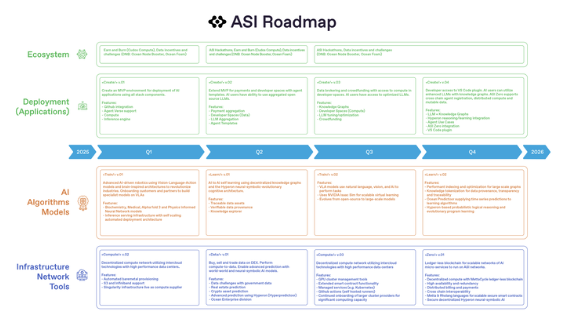
Source: ASI Official Documentation
As the adoption rate of AI increases, Fetch.ai’s AI agents and blockchain innovations can help shape the next wave of AI-driven automation.
Token Economics
Market Overview
As of March 12, 2025, Fetch.ai ($FET) has a market capitalization of $1.26 billion, with a fully diluted value (FDV) of $1.31 billion, significantly lower than its historical peak market cap of $6.76 billion. The token supply remains unchanged, with a maximum and total supply of 2.72 billion FET, while the circulating supply is 2.61 billion FET, accounting for 96% of the total supply.
Token Migration and Network Upgrade
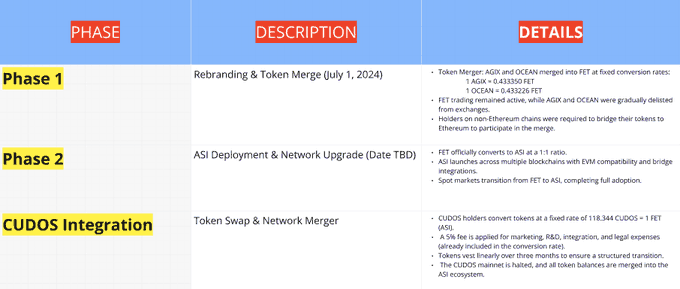
Source: Internal, ASI Alliance Official Documentation
Post-Merger Token Utility
- $FET/$ASI becomes the single token powering the Artificial Superintelligence Alliance, integrating AI agents, decentralized marketplaces, and computational infrastructure.
- This merger enhances liquidity, simplifies governance, and adjusts incentives for decentralized AI development.
- The focus remains on scalability, efficiency, and AI innovation, positioning $ASI within a broader decentralized AI economy while establishing a unified token to streamline development across ecosystems.
Conclusion
Fetch.ai and the ASI Alliance are striving to establish a foothold in the decentralized AI space, aiming to challenge centralized models through the integration of AI agents, decentralized data sharing, and blockchain-driven automation. Through initiatives such as the ASI token merger and Web3 partnerships, they focus on building an open and scalable AI ecosystem. However, challenges remain, including competition from major centralized AI companies, adoption barriers, and scalability issues.
The future of Fetch.ai and the ASI Alliance will depend on their ability to drive real adoption, strengthen their AI infrastructure, and remain competitive among centralized and decentralized AI projects. As AI agent frameworks, decentralized computing, and cross-chain integration evolve, the coming years will reveal whether these efforts can truly transform the ownership and management of AI.
免责声明:本文章仅代表作者个人观点,不代表本平台的立场和观点。本文章仅供信息分享,不构成对任何人的任何投资建议。用户与作者之间的任何争议,与本平台无关。如网页中刊载的文章或图片涉及侵权,请提供相关的权利证明和身份证明发送邮件到support@aicoin.com,本平台相关工作人员将会进行核查。




